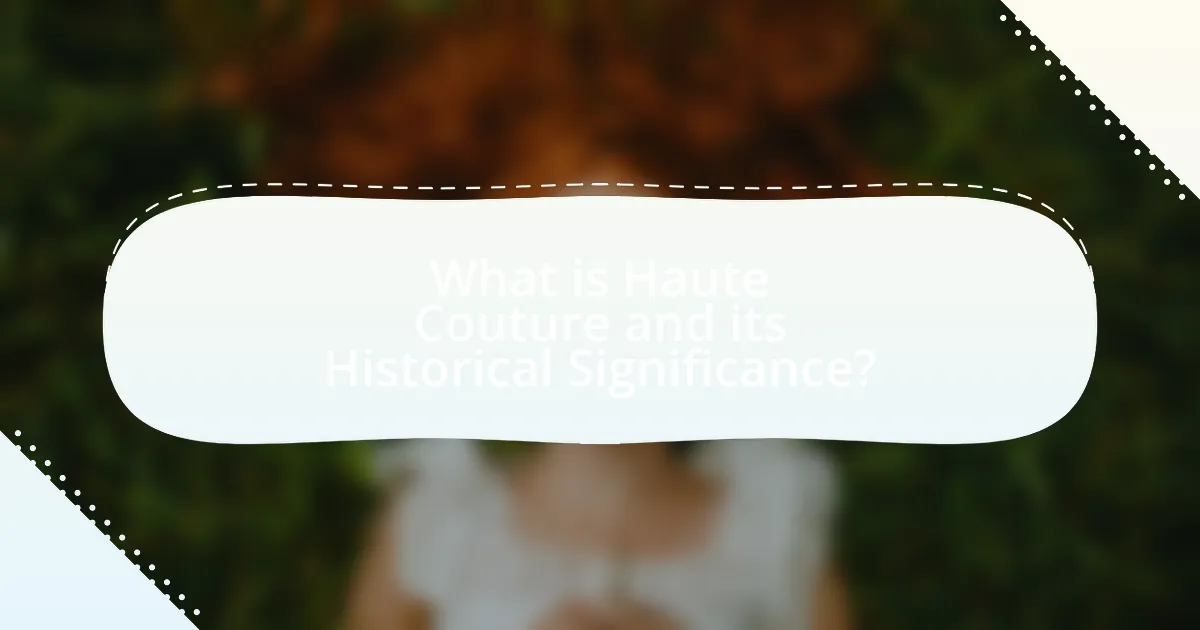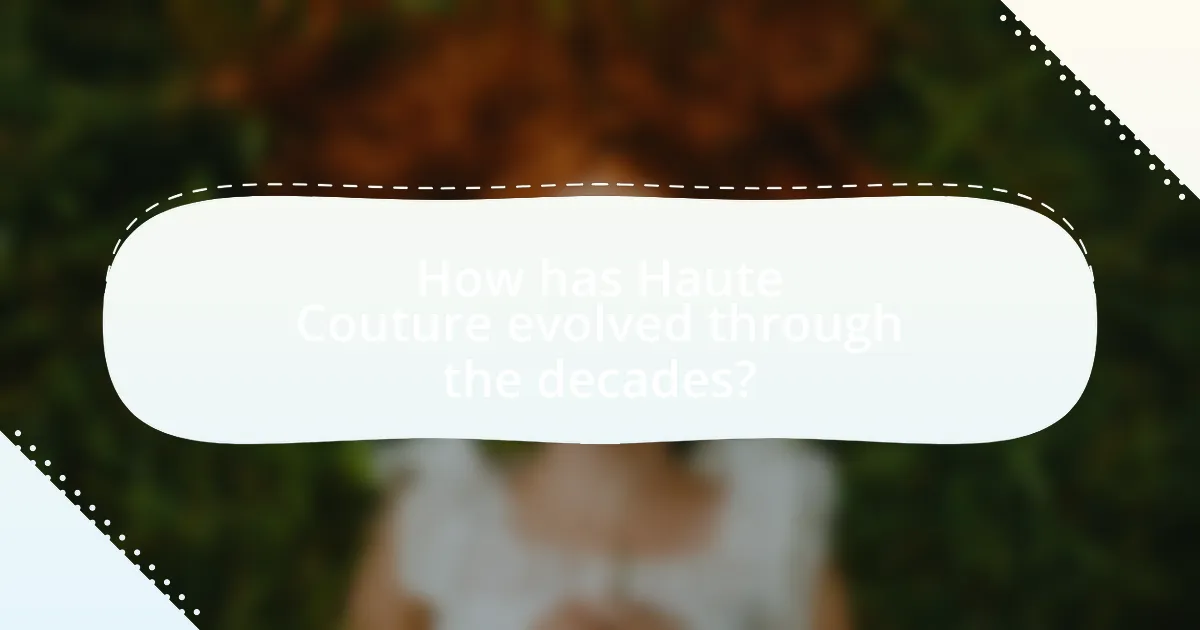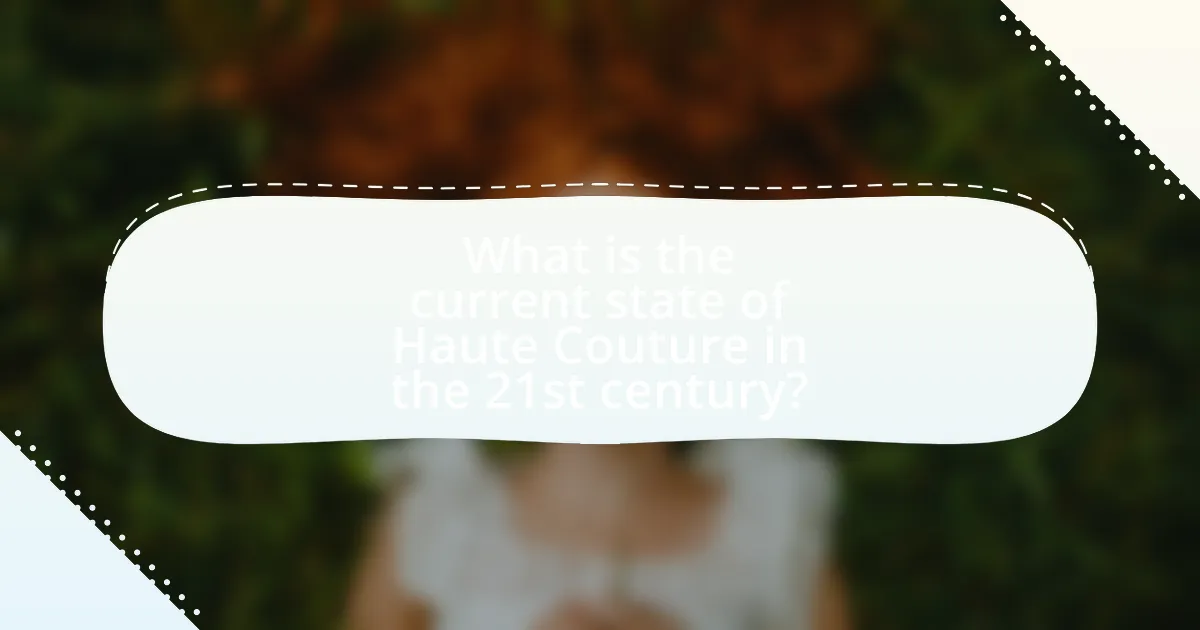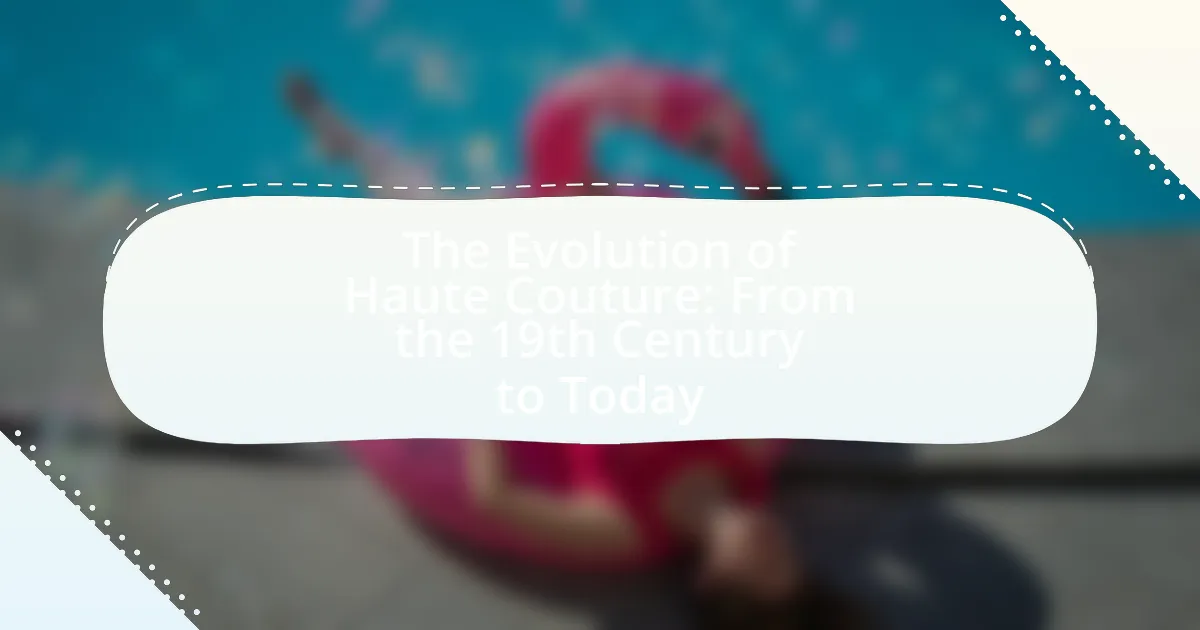Haute couture is defined as the creation of exclusive, custom-fitted clothing made by high-end fashion houses, characterized by meticulous craftsmanship and luxurious materials. The article explores the historical significance of haute couture, tracing its origins to the mid-19th century with Charles Frederick Worth, who established the first fashion house in Paris. It examines key figures who shaped the industry, societal influences on its rise, and the defining characteristics that distinguish haute couture from ready-to-wear fashion. Additionally, the article discusses the evolution of haute couture through the decades, the impact of global events, and contemporary trends, including sustainability and the influence of digital technology on marketing and consumer engagement.

What is Haute Couture and its Historical Significance?
Haute couture refers to the creation of exclusive, custom-fitted clothing made by high-end fashion houses, characterized by meticulous craftsmanship and luxurious materials. Historically, haute couture emerged in the mid-19th century, with figures like Charles Frederick Worth establishing the first fashion house in Paris, which set the standard for bespoke fashion. The significance of haute couture lies in its role as a symbol of luxury and artistry, influencing global fashion trends and establishing Paris as the epicenter of fashion innovation. The Chambre Syndicale de la Haute Couture, founded in 1868, further solidified its importance by regulating the industry and ensuring the preservation of its standards.
How did Haute Couture originate in the 19th century?
Haute Couture originated in the 19th century through the establishment of exclusive fashion houses that catered to the elite, with Charles Frederick Worth being a pivotal figure. Worth, often regarded as the father of Haute Couture, opened his fashion house in Paris in 1858, where he introduced the concept of presenting collections to clients and creating custom garments tailored to individual preferences. This marked a significant shift from previous practices, as Worth’s designs emphasized artistry and craftsmanship, setting the standard for luxury fashion. The term “Haute Couture” was officially recognized in 1945, but its roots trace back to Worth’s innovations in the mid-1800s, which laid the foundation for the haute couture industry as we know it today.
What were the key figures involved in the establishment of Haute Couture?
The key figures involved in the establishment of Haute Couture include Charles Frederick Worth, who is often regarded as the father of Haute Couture, and established the first fashion house in Paris in the mid-19th century. Worth’s innovative designs and the introduction of the fashion show concept set the foundation for the industry. Additionally, figures like Paul Poiret and Coco Chanel played significant roles in shaping Haute Couture in the early 20th century, with Poiret introducing more liberated silhouettes and Chanel revolutionizing women’s fashion with her modern designs. These individuals collectively contributed to the evolution and recognition of Haute Couture as a prestigious art form in fashion.
How did societal changes influence the rise of Haute Couture?
Societal changes significantly influenced the rise of Haute Couture by shifting fashion from a reflection of social class to an expression of individual identity and consumerism. The Industrial Revolution in the 19th century led to increased production capabilities and a growing middle class, which created a demand for luxury clothing that was previously reserved for the elite. Additionally, the emergence of fashion magazines and the rise of celebrity culture in the late 19th and early 20th centuries further popularized Haute Couture, as designers like Charles Frederick Worth began to cater to a broader audience, showcasing their creations to inspire desire among consumers. This shift in societal values towards personal expression and status through fashion solidified Haute Couture’s place in the fashion industry.
What defines Haute Couture as a fashion category?
Haute Couture is defined as a fashion category characterized by the creation of exclusive, custom-fitted clothing made from high-quality materials and crafted by skilled artisans. This category is governed by specific standards set by the Chambre Syndicale de la Haute Couture in Paris, which requires that garments be made to order for private clients and that a minimum of 50% of the garment be hand-sewn. The historical significance of Haute Couture dates back to the mid-19th century with designers like Charles Frederick Worth, who is often credited as the father of Haute Couture, establishing the practice of creating unique pieces for individual clients, thus solidifying its status as a luxury fashion segment.
What are the characteristics that distinguish Haute Couture from ready-to-wear?
Haute Couture is characterized by its bespoke nature, exclusivity, and high-quality craftsmanship, distinguishing it from ready-to-wear fashion. Haute Couture garments are custom-made for individual clients, often requiring hundreds of hours of meticulous handwork, while ready-to-wear items are mass-produced in standard sizes for a broader market. Additionally, Haute Couture adheres to strict regulations set by the Chambre Syndicale de la Haute Couture, which mandates specific criteria such as the use of high-quality fabrics and a minimum number of fittings. This level of personalization and artistry in Haute Couture contrasts sharply with the more accessible and commercially driven approach of ready-to-wear collections.
How is Haute Couture regulated and recognized today?
Haute Couture is regulated and recognized today primarily by the Chambre Syndicale de la Haute Couture in Paris, which establishes strict criteria for a fashion house to be officially designated as a haute couture brand. This organization requires that a brand produce made-to-measure garments for private clients, with a minimum of 50 original designs presented in a fashion show each season. Additionally, the garments must be crafted in Paris by skilled artisans, ensuring high standards of craftsmanship and exclusivity. This regulation maintains the integrity and prestige of haute couture, distinguishing it from ready-to-wear fashion.

How has Haute Couture evolved through the decades?
Haute Couture has evolved significantly through the decades, transitioning from exclusive, handcrafted garments in the 19th century to a more diverse and commercially viable fashion industry today. In the late 1800s, Charles Frederick Worth established the foundation of Haute Couture by creating custom garments for wealthy clients, emphasizing craftsmanship and individuality. The early 20th century saw designers like Coco Chanel and Christian Dior introduce revolutionary styles, such as the flapper dress and the New Look, which reshaped women’s fashion.
By the mid-20th century, Haute Couture became more accessible, with designers like Yves Saint Laurent democratizing fashion through ready-to-wear collections. The late 20th century and early 21st century witnessed the rise of global fashion weeks and the influence of street style, leading to a blend of Haute Couture with contemporary trends. Today, Haute Couture is characterized by a fusion of traditional techniques and modern aesthetics, with designers like Valentino and Chanel continuing to innovate while maintaining the essence of luxury and exclusivity. This evolution reflects broader societal changes, including shifts in gender roles and the impact of technology on fashion production and consumption.
What major trends shaped Haute Couture in the early 20th century?
Major trends that shaped Haute Couture in the early 20th century include the rise of the modern fashion house, the influence of art movements, and the introduction of ready-to-wear collections. The establishment of iconic fashion houses like Chanel and Dior marked a shift towards structured, innovative designs that emphasized both elegance and practicality. Additionally, movements such as Art Deco and Surrealism inspired designers to experiment with bold colors, geometric patterns, and unconventional silhouettes. The emergence of ready-to-wear collections in the 1920s made high fashion more accessible, allowing a broader audience to engage with couture styles. These trends collectively transformed Haute Couture into a dynamic and influential sector of the fashion industry.
How did the World Wars impact the Haute Couture industry?
The World Wars significantly transformed the Haute Couture industry by altering production methods and shifting consumer demand. During World War I, fabric shortages and the need for practicality led designers to create simpler, more utilitarian garments, while World War II further accelerated this trend, as rationing limited materials and influenced styles towards more functional clothing. Notably, the introduction of synthetic fabrics during this period allowed for innovation in design despite material constraints. Additionally, the wars prompted a move towards ready-to-wear fashion, as many consumers sought affordable alternatives to high-end couture, reshaping the industry’s landscape and leading to the eventual rise of prêt-à-porter.
What role did iconic designers play in the evolution of Haute Couture during this period?
Iconic designers were pivotal in shaping Haute Couture by introducing innovative techniques, styles, and philosophies that defined the fashion landscape. For instance, Charles Frederick Worth, often regarded as the father of Haute Couture, established the practice of presenting collections and personalized fittings, which set the standard for future designers. Coco Chanel revolutionized women’s fashion by introducing more casual elegance and breaking away from the constraints of corsetry, thus influencing the silhouette of the 20th century. Christian Dior’s “New Look” in 1947 redefined femininity with its emphasis on a cinched waist and full skirts, revitalizing the post-war fashion industry. These designers not only created iconic garments but also influenced cultural perceptions of fashion, making Haute Couture a symbol of luxury and artistry.
How did the late 20th century redefine Haute Couture?
The late 20th century redefined Haute Couture by introducing a blend of artistic expression and commercial viability, shifting the focus from exclusive craftsmanship to broader accessibility and innovation. Designers like Jean-Paul Gaultier and Vivienne Westwood challenged traditional norms, incorporating streetwear elements and cultural references into their collections, which expanded the definition of Haute Couture beyond classic elegance. This period also saw the rise of fashion shows as major media events, exemplified by the 1989 “The Fashion Show” at the Louvre, which highlighted the intersection of art and fashion, further solidifying Haute Couture’s place in contemporary culture.
What innovations in design and technology influenced Haute Couture in the 1980s and 1990s?
Innovations in design and technology that influenced Haute Couture in the 1980s and 1990s include the introduction of computer-aided design (CAD) and advancements in fabric technology. CAD allowed designers to create intricate patterns and visualize garments digitally, streamlining the design process and enhancing creativity. Additionally, the development of synthetic fabrics, such as Lycra and Gore-Tex, expanded the possibilities for garment construction, enabling more innovative silhouettes and functional designs. These technological advancements were pivotal in shaping the aesthetic and practical aspects of Haute Couture during this period, as evidenced by collections from designers like Jean-Paul Gaultier and Thierry Mugler, who embraced these innovations to push the boundaries of fashion.
How did globalization affect the Haute Couture landscape?
Globalization significantly transformed the Haute Couture landscape by expanding its market reach and diversifying its influences. As fashion houses began to operate on a global scale, they accessed new consumer bases, particularly in emerging markets like Asia and the Middle East, which increased sales and brand visibility. This shift led to a blending of cultural aesthetics, as designers incorporated global trends and materials into their collections, exemplified by the rise of cross-cultural collaborations and the integration of traditional craftsmanship from various regions. The impact of globalization is evident in the increased presence of international fashion weeks and the digitalization of fashion marketing, allowing Haute Couture to engage with a broader audience through online platforms.

What is the current state of Haute Couture in the 21st century?
The current state of Haute Couture in the 21st century is characterized by a blend of traditional craftsmanship and modern innovation, with a focus on sustainability and inclusivity. Major fashion houses like Chanel, Dior, and Valentino continue to produce exquisite, one-of-a-kind garments, while also adapting to contemporary consumer demands. The rise of digital platforms has expanded accessibility, allowing a broader audience to engage with Haute Couture, evidenced by live-streamed fashion shows and online sales. Additionally, the integration of sustainable practices, such as the use of eco-friendly materials and ethical production methods, reflects a significant shift in the industry, responding to growing environmental concerns. This evolution demonstrates that Haute Couture remains relevant by embracing change while maintaining its core values of artistry and exclusivity.
How do contemporary designers approach Haute Couture today?
Contemporary designers approach Haute Couture by blending traditional craftsmanship with modern aesthetics and innovative techniques. They emphasize personalization and sustainability, often incorporating eco-friendly materials and practices into their collections. For instance, designers like Iris van Herpen utilize 3D printing technology to create intricate designs that push the boundaries of conventional couture. This integration of technology and artistry reflects a shift towards a more inclusive and diverse representation of beauty, catering to a broader audience while maintaining the exclusivity that defines Haute Couture.
What are the current trends in materials and techniques used in Haute Couture?
Current trends in materials and techniques used in Haute Couture include the use of sustainable fabrics, innovative textile technologies, and a blend of traditional craftsmanship with modern design. Designers are increasingly opting for eco-friendly materials such as organic cotton, recycled polyester, and biodegradable fabrics to address environmental concerns. Additionally, advancements in textile technology, such as 3D printing and digital fabric printing, allow for intricate designs and customization that were previously unattainable. The integration of handcraft techniques, like embroidery and beading, continues to be essential, showcasing the artistry and skill inherent in Haute Couture. These trends reflect a commitment to sustainability and innovation while maintaining the luxurious essence of Haute Couture.
How has social media transformed the marketing of Haute Couture?
Social media has transformed the marketing of Haute Couture by enabling direct engagement between designers and consumers, significantly broadening the audience reach. Platforms like Instagram and TikTok allow Haute Couture brands to showcase their collections in real-time, creating a sense of immediacy and accessibility that was previously unattainable. For instance, the 2021 Met Gala saw designers leveraging social media to generate buzz and showcase their creations to millions, illustrating the power of these platforms in shaping public perception and driving sales. This shift has led to increased visibility for emerging designers and a more democratized fashion landscape, where traditional barriers to entry are lowered.
What challenges does Haute Couture face in the modern fashion industry?
Haute Couture faces significant challenges in the modern fashion industry, primarily due to the rise of fast fashion, changing consumer preferences, and economic pressures. Fast fashion brands produce clothing at a rapid pace and lower cost, making it difficult for Haute Couture, which emphasizes craftsmanship and exclusivity, to compete on price and accessibility. Additionally, consumers increasingly prioritize sustainability and ethical production, which can conflict with the traditional practices of Haute Couture that often involve extensive resource use and labor. Economic downturns also impact luxury spending, leading to decreased demand for high-end custom garments. These factors collectively threaten the viability and relevance of Haute Couture in today’s fashion landscape.
How do sustainability and ethical considerations impact Haute Couture practices?
Sustainability and ethical considerations significantly impact Haute Couture practices by driving designers to adopt eco-friendly materials and ethical labor practices. The fashion industry, particularly Haute Couture, has faced scrutiny for its environmental footprint and labor conditions, prompting a shift towards sustainable sourcing and transparency. For instance, brands like Stella McCartney have pioneered the use of organic fabrics and cruelty-free production methods, demonstrating a commitment to reducing waste and promoting ethical labor. This shift is supported by consumer demand for responsible fashion, with a 2021 McKinsey report indicating that 67% of consumers consider sustainability when making a purchase. Thus, sustainability and ethics are reshaping Haute Couture, influencing design choices, production methods, and consumer engagement.
What is the future outlook for Haute Couture in a rapidly changing fashion world?
The future outlook for Haute Couture in a rapidly changing fashion world is one of adaptation and innovation, as it seeks to balance traditional craftsmanship with contemporary consumer demands. Haute Couture houses are increasingly embracing digital technologies, such as virtual fashion shows and online customization, to reach a broader audience and enhance customer engagement. For instance, brands like Balenciaga and Dior have successfully integrated digital platforms to showcase their collections, reflecting a shift towards a more accessible and interactive experience. Additionally, sustainability is becoming a crucial factor, with many couture designers focusing on eco-friendly materials and ethical production practices, aligning with the growing consumer preference for responsible fashion. This evolution indicates that Haute Couture will continue to thrive by merging its rich heritage with modern trends and values.
What practical insights can be drawn from the evolution of Haute Couture?
The evolution of Haute Couture reveals practical insights into the fashion industry’s adaptability and the significance of craftsmanship. Haute Couture has transitioned from exclusive, handcrafted garments in the 19th century to a more inclusive approach that embraces ready-to-wear collections, reflecting changing consumer demands and economic conditions. For instance, the establishment of the Chambre Syndicale de la Haute Couture in 1945 formalized standards, ensuring quality and authenticity, which underscores the importance of maintaining high standards in fashion. Additionally, the rise of digital technology and social media has transformed marketing strategies, allowing designers to reach broader audiences while preserving the essence of luxury and exclusivity. This evolution illustrates the necessity for innovation and responsiveness in the fashion industry to remain relevant and successful.
How can emerging designers learn from the history of Haute Couture?
Emerging designers can learn from the history of Haute Couture by studying its foundational principles, techniques, and the evolution of fashion trends. Haute Couture, which began in the mid-19th century with designers like Charles Frederick Worth, established standards for craftsmanship, exclusivity, and artistic expression in fashion. By analyzing the meticulous techniques used in Haute Couture, such as hand-sewing, draping, and fabric manipulation, emerging designers can enhance their skills and create garments that reflect high-quality craftsmanship. Additionally, understanding the socio-economic and cultural contexts that influenced Haute Couture, such as the impact of World War I and II on fashion, can provide insights into how to adapt and innovate in contemporary design. Historical examples, like the rise of Christian Dior’s “New Look” in 1947, illustrate how designers can respond to societal changes and consumer desires, offering valuable lessons in market responsiveness and creativity.
What best practices can be adopted from successful Haute Couture houses?
Successful Haute Couture houses adopt several best practices that contribute to their enduring success. These practices include meticulous craftsmanship, personalized client experiences, and innovative design techniques. For instance, houses like Chanel and Dior emphasize the importance of hand-sewn garments, ensuring high-quality craftsmanship that sets them apart in the luxury market. Additionally, they cultivate strong relationships with clients through bespoke services, allowing for tailored experiences that enhance customer loyalty. Furthermore, successful couture houses often embrace innovation by integrating modern technology and sustainable practices into their design processes, which not only appeals to contemporary consumers but also aligns with evolving industry standards. These strategies collectively reinforce their brand prestige and market relevance.

Leave a Reply